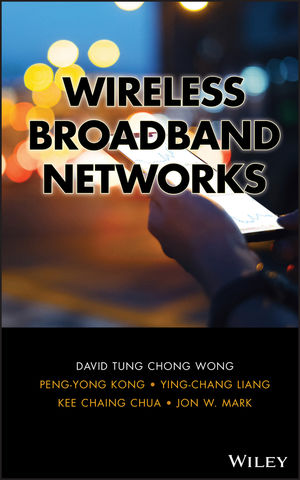Wireless Broadband NetworksISBN: 978-0-470-18177-5
Hardcover
528 pages
March 2009
 |
||||||
Preface xiii
I Enabling Technologies for Wireless Broadband Networks 1
1 Orthogonal Frequency-Division Multiplexing and Other Block-Based Transmissions 3
1.1 Introduction 3
1.2 Wireless Communication Systems 3
1.3 Block-Based Transmissions 5
1.4 Orthogonal Frequency-Division Multiplexing Systems 9
1.5 Single-Carrier Cyclic Prefix Systems 11
1.6 Orthogonal Frequency-Division Multiple Access 12
1.7 Interleaved Frequency-Division Multiple Access 13
1.8 Single-Carrier Frequency-Division Multiple Access 16
1.9 CP-Based Code Division Multiple Access 17
1.10 Receiver Design 18
Summary 25
Appendix 26
References 27
2 Multiple-Input, Multiple-Output Antenna Systems 31
2.1 Introduction 31
2.2 MIMO System Model 32
2.3 Channel Capacity 33
2.4 Diversity 42
2.5 Diversity and Spatial Multiplexing Gain 43
2.6 SIMO Systems 44
2.7 MISO Systems 45
2.8 Space–Time Coding 45
2.9 MIMO Transceiver Design 50
2.10 SVD-Based Eigen-Beamforming 52
2.11 MIMO for Frequency-Selective Fading Channels 52
2.12 Transmitting Diversity for Frequency-Selective Fading Channels 56
2.13 Cyclic Delay Diversity 59
Summary 62
References 62
3 Ultrawideband 65
3.1 Introduction 65
3.2 Time-Hopping Ultrawideband 67
3.3 Direct Sequence Ultrawideband 84
3.4 Multiband 94
3.5 Other Types of UWB 97
Summary 107
References 110
4 Medium Access Control 115
4.1 Introduction 115
4.2 Slotted ALOHA MAC 117
4.3 Carrier-Sense Multiple Access with Collision Avoidance MAC 119
4.4 Polling MAC 126
4.5 Reservation MAC 127
4.6 Energy-Efficient MAC 132
4.7 Multichannel MAC 139
4.8 Directional-Antenna MAC 141
4.9 Multihop Saturated Throughput of IEEE 802.11 MAC 147
4.10 Multiple-Access Control 156
Summary 161
References 161
5 Mobility Resource Management 165
5.1 Introduction 165
5.2 Types of Handoffs 167
5.3 Handoff Strategies 169
5.4 Channel Assignment Schemes 170
5.5 Multiclass Channel Assignment Schemes 195
5.6 Location Management 218
5.7 Mobile IP 220
5.8 Cellular IP 221
5.9 HAWAII 222
Summary 223
References 224
6 Routing Protocols for Multihop Wireless Broadband Networks 227
6.1 Introduction 227
6.2 Multihop Wireless Broadband Networks: Mesh Networks 227
6.3 Importance of Routing Protocols 230
6.4 Routing Metrics 239
6.5 Classification of Routing Protocols 245
6.6 MANET Routing Protocols 254
Summary 262
References 262
7 Radio Resource Management for Wireless Broadband Networks 267
7.1 Introduction 267
7.2 Packet Scheduling 268
7.3 Admission Control 295
Summary 303
References 304
8 Quality of Service for Multimedia Services 307
8.1 Introduction 307
8.2 Traffic Models 309
8.3 Quality of Service in Wireless Systems 321
8.4 Outage Probability for Video Services in a Multirate DS-CDMA System 326
Summary 336
References 337
II Systems for Wireless Broadband Networks 339
9 Long-Term-Evolution Cellular Networks 341
9.1 Introduction 341
9.2 Network Architecture 343
9.3 Physical Layer 343
9.4 Medium Access Control Scheduling 354
9.5 Mobility Resource Management 361
9.6 Radio Resource Management 362
9.7 Security 363
9.8 Quality of Service 364
9.9 Applications 365
Summary 365
References 366
10 Wireless Broadband Networking with WiMAX 367
10.1 Introduction 367
10.2 WiMAX Overview 367
10.3 Competing Technologies 370
10.4 Overview of the Physical Layer 371
10.5 PMP Mode 374
10.6 Mesh Mode 378
10.7 Multihop Relay Mode 384
Summary 387
References 387
11 Wireless Local Area Networks 391
11.1 Introduction 391
11.2 Network Architectures 393
11.3 Physical Layer of IEEE 802.11n 393
11.4 Medium Access Control 404
11.5 Mobility Resource Management 422
11.6 Quality of Service 425
11.7 Applications 426
Summary 426
References 427
12 Wireless Personal Area Networks 429
12.1 Introduction 429
12.2 Network Architecture 430
12.3 Physical Layer 431
12.4 Medium Access Control 437
12.5 Mobility Resource Management 459
12.6 Routing 460
12.7 Quality of Service 460
12.8 Applications 460
Summary 461
References 461
13 Convergence of Networks 463
13.1 Introduction 463
13.2 3GPP/WLAN Interworking 464
13.3 IEEE 802.11u Interworking with External Networks 467
13.4 LAN/WLAN/WiMax/3G Interworking Based on IEEE 802.21 Media-Independent Handoff 468
13.5 Future Cellular/WiMax/WLAN/WPAN Interworking 471
13.6 Analytical Model for Cellular/WLAN Interworking 474
Summary 478
References 478
Appendix Basics of Probability, Random Variables, Random Processes, and Queueing Systems 481
A.1 Introduction 481
A.2 Probability 481
A.3 Random Variables 483
A.4 Poisson Random Process 486
A.5 Birth–Death Processes 487
A.6 Basic Queueing Systems 489
References 501
Index 503



